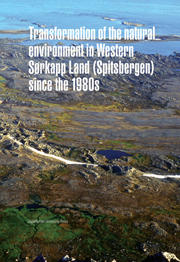Botanical research
from Methods and materials
Published online by Cambridge University Press: 05 September 2014
Summary
During the 1982 and 1985 summer seasons, extensive vegetation research was carried out in northwest Sørkapp Land. The study area included marine terraces along the northern and western shores of Sørkapp Land, from the Lisbetelva river to the Vinda river, Hohenlohefjellet (614 m), as well as the western slopes of Sergeijevfjellet and Lidfjellet.
Western Sørkapp Land is diverse in terms of habitat conditions such as: topography, bedrock, hydrological and edaphic relationships and microclimate. Lichens and bryophytes are predominant along with a few flowering plants, creating a complex mosaic of vegetation (Fig. 4).
Phytosociological research led to the identification of 28 vegetation units in the study area. The basis for the identification was 285 phytosociological relevés, performed according to the Braun-Blanquet (1964) method. Relevés were taken at different locations in order to obtain a full picture of the variety of vegetation. Complete phytosociological tables were created for 28 plant communities (Dubiel, Olech 1990). Plant communities were selected on the basis of their floristic characteristics. In some cases, the presence of dominant species strongly influencing the physiognomy of patches was considered more important. A short description of the habitat as well as comments on the distribution were added to the descriptions of vegetation. Names of differential species and their ecological scale were given for each community.
- Type
- Chapter
- Information
- Transformation of the Natural Environment in Western Sorkapp Land (Spitsbergen) since the 1980s , pp. 21 - 24Publisher: Jagiellonian University PressPrint publication year: 2011



